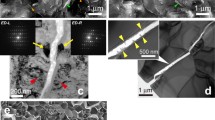Abstract
A mechanism for the consolidation (performed experimentally earlier) of brittle quartz powder particles under a strong external action (high-pressure torsion) is proposed. This mechanism is based on possible destruction of silicon–oxygen tetrahedra via breakage of the Si–O interatomic bonds. The surface layer of the ceramic powder particles is shown to contain initial tetrahedra and their “fragments,” i.e., defects of the tetrahedra (proposed for the first time by the authors together with the name). The emergence of the tetrahedra and their fragments to the surface by the faces, edges, and vertices predetermines the surface shape and, eventually, surface adhesion. The enhancement of an external action results in healing broken Si–O bonds, which predetermines the possibility of partial or complete consolidation.




Similar content being viewed by others
REFERENCES
M. Knoll, “Glasses, quartz and ceramics, and their use in tube design,” Mater. Proc. Electron Devices, 203–257 (1959).
J. P. Powers, Introduction to Fiber Optic Systems (McGraw-Hill Professional, 1996).
W. D. Callister and D. G. Rethwisch, Materials Science and Engineering—An Introduction (Wiley, New York, 2007).
S. S. Nekrashevich and V. A. Gritsenko, “Electronic structure of silicon dioxide,” Phys. Solid State 56, 207–222 (2014).
R. Z. Valiev and I. V. Aleksandrov, Bulk Nanostructured Metallic Materials: Production, Structure, and Properties (Akademkniga, Moscow, 2007).
A. P. Zhilyaev and T. G. Langdon, “Using high-pressure torsion for metal processing: Fundamentals and applications,” Prog. Mater. Sci. 53, 893–979 (2008).
Yu. R. Kolobov, R. Z. Valiev, G. P. Grabovetskaya, V. P. Zhilyaev, E. F. Dudarev, K. V. Ivanov, O. A. Kashin, and E. V. Naidenkin, Grain-Boundary Diffusion and Properties of Nanostructured Materials (Nauka, Novosibirsk, 2001).
B. A. Greenberg, M. A. Ivanov, V. P. Pilyugin, A. M. Patselov, and T. P. Tolmachev, “Role of crushing-induced fragmentation in the consolidation of quartz ceramic and glass powders during high-pressure torsion,” Russ. Metall. (Metally), No. 10, 821–830 (2017).
B. A. Greenberg, M. A. Ivanov, V. P. Pilyugin, M. S. Pushkin, A. V. Plotnikov, T. P. Tolmachev, A. M. Patselov, and A. P. Tankeev, “Microstructural analysis of the Ni3Ge intermetallic compound after high pressure torsion,” Russ. Metall. (Metally), No. 10, 921–934 (2018).
O. V. Antonova, Yu. P. Besshaposhnikov, A. M. Vlasova, B. A. Grinberg, et al., Explosive Welding: Processes and Structures (Innovats. Mashinostr., Moscow, 2017).
B. A. Greenberg, M. A. Ivanov, A. V. Inozemtsev, A. M. Patselov, M. S. Pushkin, and A. M. Vlasova, “Microheterogeneous structure of local melted zones in the process of explosive welding,” Metall. Mater. Trans. A 46, 3569–3580 (2015).
S. L. Chaplot and S. K. Sikka, “Molecular-dynamic simulation of pressure-induced crystalline-to-amorphous transition in some corner-linked polyhedral compounds,” Phys. Rev. B 47 (10), 5710–5714 (1993).
L. W. Hobbs, C. E. Jesurum, V. Pulim, and B. Berger, “Local topology of silica networks,” Philos. Mag. A, No. 3, 679–711 (1998).
Funding
This work was carried out in terms of a state assignment of the Ministry of Education and Science of the Russian Federation (project Pressure no. AAAA-A18-118020190104-3) and was supported in part by the Russian Foundation for Basic Research (projects nos. 17-02-00025 and 20-42-660001).
Author information
Authors and Affiliations
Corresponding author
Additional information
Translated by E. Yablonskaya
Rights and permissions
About this article
Cite this article
Greenberg, B.A., Ivanov, M.A., Pilyugin, V.P. et al. Silicon–Oxygen Quartz Tetrahedra and Consolidation Processes during High-Pressure Torsion. Russ. Metall. 2021, 449–453 (2021). https://doi.org/10.1134/S003602952104011X
Received:
Revised:
Accepted:
Published:
Issue Date:
DOI: https://doi.org/10.1134/S003602952104011X




